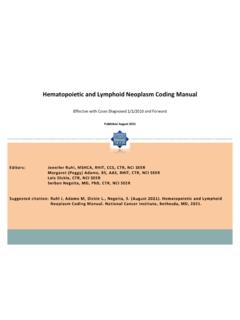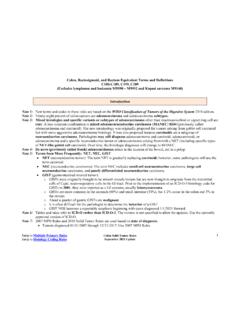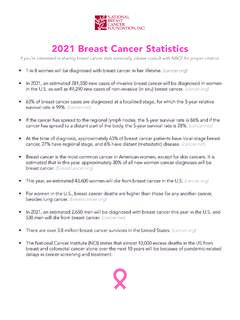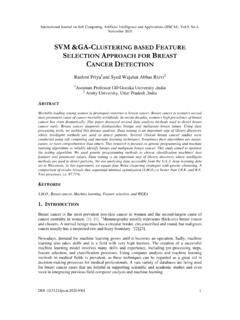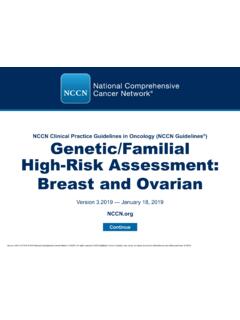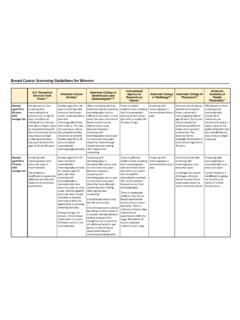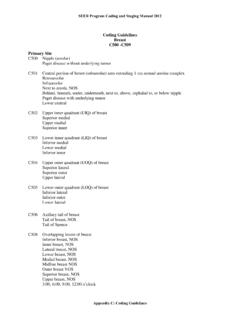Transcription of Breast Coding Guidelines
1 Coding Guidelines Breast C500 -C509 Primary Site C500 Nipple (areolar) Paget disease without underlying tumor C501 Central portion of Breast (subareolar) area extending 1 cm around areolar complex Retroareolar Infraareolar Next to areola, NOS Behind, beneath, under, underneath, next to, above, cephalad to, or below nipple Paget disease with underlying tumor Lower central C502 Upper inner quadrant (UIQ) of Breast Superior medial Upper medial Superior inner C503 Lower inner quadrant (LIQ) of Breast Inferior medial Lower medial Inferior inner C504 Upper outer quadrant (UOQ) of Breast Superior lateral Superior outer Upper lateral C505 Lower outer quadrant (LOQ) of Breast Inferior lateral Inferior outer Lower lateral C506 Axillary tail of Breast Tail of Breast , NOS Tail of Spence C508 Overlapping lesion of Breast Inferior Breast , NOS Inner Breast , NOS Lateral Breast , NOS Lower Breast , NOS Medial Breast , NOS Midline Breast NOS Outer Breast NOS Superior Breast , NOS Upper Breast , NOS 3:00, 6:00, 9:00, 12:00 o clock C509 Breast , NOS Entire Breast Multiple tumors in different subsites within Breast Inflammatory without palpable mass or more of Breast involved with tumor Diffuse (tumor size 998) Additional Subsite Descriptors The position of the tumor in the Breast may be described as the positions on a clock Coding Subsites Use the information from reports in the following priority order to code a subsite when there is conflicting information: 1.
2 Pathology report 2. Operative report 3. Physical examination 4. Mammogram, ultrasound Code the subsite with the invasive tumor when the pathology report identifies invasive tumor in one subsite and in situ tumor in involved different subsite or subsites. Code the subsite with the invasive tumor when the pathology report identifies invasive tumor in one subsite and in situ tumor in a different subsite or subsites. Code the specific quadrant for multifocal tumors all within one quadrant Do not code C509 ( Breast , NOS) in this situation O'Clock Positions and Codes Quadrants of Breasts 2 1 12 11 10 9 8 7 6 5 4 3 2 1 12 11 10 9 8 7 6 5 4 3 RIGHT Breast LEF T Breast UIQ UIQ UOQ UOQ LOQ LOQ LIQ LIQ Code the primary site to C508 when there is a single tumor in two or more subsites and the subsite in which the tumor originated is unknown there is a single tumor located at the 12, 3, 6, or 9 o clock position on the Breast Code the primary site to C509 when there are multiple tumors (two or more) in at least two quadrants of the Breast Grade Note: These Guidelines pertain to the data item Grade.
3 Refer to the Collaborative Stage Data Collection Manual for instructions on Coding site-specific factors for Breast cases. Invasive Carcinoma The pathologist assigns a numeric value to each of three tumor characteristics: tubule formation, nuclear pleomorphism, and mitotic counts. The three values are added together and the result is a score ranging from 3 to 9. Use the table below to convert scores to SEER code. Convert Nottingham Histologic Score or BR Grade to SEER Code Grade Conversion Table for Invasive Carcinoma Priority Rules for Grading Breast Cancer Code the tumor grade using the following priority order: 1. Bloom-Richardson (Nottingham) scores 3-9 converted to grade (see conversion table above) 2. Bloom Richardson grade (low, intermediate, high) 3. Nuclear grade only 4. Terminology 5. Differentiation (well differentiated, moderately differentiated, etc) 6. Histologic grade 7. Grade i, grade ii, grade iii, grade iv 8.
4 Bloom-Richardson (BR) Nottingham combined histologic grade is also known as Elston-Ellis modification of Scarff-Bloom-Richardson grading system. BR may also be called: modified Bloom-Richardson, Scarff-Bloom-Richardson, SBR grading, BR grading, Elston-Ellis modification of Bloom Richardson score, the Nottingham modification of Bloom Richardson score, Nottingham-Tenovus, or Nottingham grade BR may be expressed in scores (range 3-9) The score is based on three morphologic features of invasive no-special-type Breast cancers (degree of tubule formation/histologic grade, mitotic activity, nuclear pleomorphism of tumor cells) Nottingham Histologic Scores BR Grade Nuclear Grade Terminology Histologic Grade SEER Code 3-5 Low 1/3; 1/2 Well differentiated I, I/III, 1/3 1 6, 7 Intermediate 2/3 Moderately differentiated II, II/III; 2/3 2 8, 9 High 2/2; 3/3 Poorly differentiated III, III/III, 3/3 3 --- --- 4/4 Undifferentiated/anaplastic IV, IV/IV, 4/4 4 Use the preceding table to convert the score into SEER code.
5 BR may be expressed as a grade (low, intermediate, high) BR grade is derived from the BR score For cases diagnosed 1996 and later, use the preceding table to convert the BR grade into SEER code (Note that the conversion of low, intermediate, and high is different from the conversion used for all other tumors). DCIS Ductal carcinoma in situ (DCIS) is not always graded. When DCIS is graded, it is generally divided into three grades: low grade, intermediate grade, and high grade. Use the following table to convert DCIS grade into the SEER code. DCIS Grade Conversion Table DCIS Grade Terminology SEER Code Grade I Low 1 Grade II Intermediate 2 Grade III High 3 Laterality Laterality must be coded for all subsites. Breast primary with positive nodes and no Breast mass found: Code laterality to the side with the positive nodes





